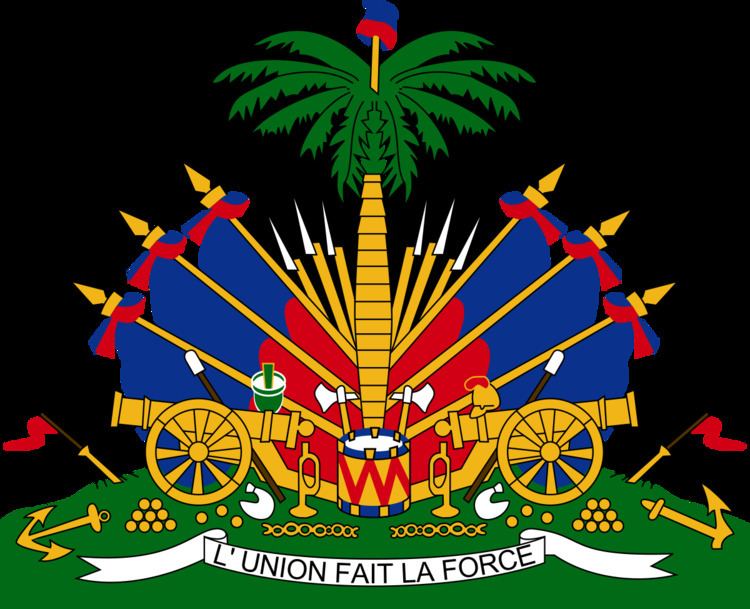 | ||
The Government of Haiti consists of a semi-pr, pluriform multiparty system whereby the President of Haiti is head of state directly elected by popular vote. The Prime Minister acts as head of government, and is appointed by the President from the majority party in the National Assembly. Executive power is exercised by the President and Prime Minister who together constitute this branch of government. Legislative power is vested in both the government and the two chambers of the National Assembly of Haiti. The government is organized unitarily, thus the central government delegates powers to the departments without a constitutional need for consent. The current structure of Haiti's political system was set forth in the Constitution of March 29, 1987.
Contents
- Map of Haiti
- Government
- History
- Executive branch
- President
- Cabinet
- Legislative branch
- Judicial branch
- Administrative divisions
- References
Map of Haiti
Government
The government of Haiti is a semi-presidential republic, a multiparty system wherein the President of Haiti is head of state elected directly by popular elections. The Prime Minister acts as head of government and is appointed by the President, chosen from the majority party in the National Assembly. Executive power is exercised by the President and Prime Minister who together constitute the government.
Legislative power is vested in both the government and the two chambers of the National Assembly of Haiti. The government is organized unitarily, thus the central government delegates powers to the departments without a constitutional need for consent. The current structure of Haiti's political system was set forth in the Constitution of Haiti on 29 March 1987. The current president is Jovenel Moïse, elected in 2016 and sworn in on February 7, 2017.
In 2010, there were 7,000 people in the Haitian National Police.
The Institute for the Protection of National Heritage has preserved 33 historical monuments and the historic center of Cap-Haïtien.
The legal system for torts is based on a version of the Napoleonic Code.
In 2013, the annual budget was US$1 billion.
History
Haiti is officially a semi-presidential republic, although it is often claimed to be authoritarian in practice. Suffrage is universal, for adults over 18.
The constitution was modeled after those of the United States and of France. It was approved in March 1987, but it was completely suspended from June 1988 to March 1989 and was only fully reinstated in October 1994.
Executive branch
Haiti's executive branch is composed of two parts, the presidency and the government. In this sense, "government" refers specifically to the portion of the executive branch outside of the presidency, and not to Haiti's political system as a whole.
President
The president is the head of state and elected by popular vote every five years for a five-year term, and may not serve consecutive terms. The last presidential election was held on 20 November 2016. The current president is Jovenel Moïse.
The president is assisted by the prime minister and his cabinet, which must be ratified by the National Assembly.
Cabinet
Haiti's cabinet is led by the Prime Minister, and includes other ministers.
The prime minister, the head of government, is appointed by the president and ratified by the National Assembly. He appoints the Ministers and Secretaries of State and goes before the National Assembly to obtain a vote of confidence for his declaration of general policy. The Prime Minister enforces the laws and, along with the President, is responsible for national defense.
The ministries of the Haitian government are:
Legislative branch
The bicameral National Assembly of Haiti (Assemblée Nationale) consists of the Chamber of Deputies (Chambre des Députés) and the Senate (Sénat). The Chamber of Deputies has ninety-nine members, who are elected by popular vote for four-year terms. The Senate consists of thirty members elected by popular vote to serve six-year terms, with one third elected every two years.
The last Senate elections were held on 28 November 2010 with run-off elections on 20 March 2011. The following Senate election, for one third of the seats, was to be held in 2012 but was not called. The last election of the Chamber of Deputies was held on 28 November 2010 with run-off elections on 20 March 2011. The next regular election of Deputies is to be held in 2014.
Prior to a 2002 territorial law which created a tenth department, the Chamber of Deputies had eighty three seats and the Senate had twenty-seven.
Judicial branch
The legal system is based on the Roman civil law system. Haiti accepts compulsory jurisdiction of the International Court of Justice. There is a Supreme Court (Cour de Cassation), assisted by local and civil courts at a communal level.
The Chief Justice of the Supreme Court, is in line to succeed the President in case of death or resignation, according to the 1987 Constitution of Haiti.
Administrative divisions
For reasons of administration, Haiti has been divided into ten departments. Each department is divided into from three to seven arrondissements, and arrondissements are further divided into communes. The departments are listed below, with the departmental capital cities in parentheses.
- Artibonite (Gonaïves)
- Centre (Hinche)
- Grand'Anse (Jérémie)
- Nippes (Miragoâne)
- Nord (Cap-Haïtien)
- Nord-Est (Fort-Liberté)
- Nord-Ouest (Port-de-Paix)
- Ouest (Port-au-Prince)
- Sud-Est (Jacmel)
- Sud (Les Cayes)
The departments are further divided into 41 arrondissements, and 133 communes, which serve as second- and third-level administrative divisions.
